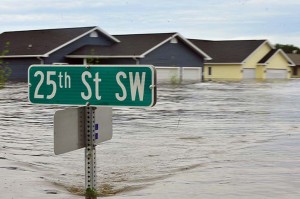The U.S. Federal Emergency Management Agency (FEMA) has begun its procurement process for a 2017 flood reinsurance program for its National Flood Insurance Program, as it seeks to push more of the risk into private risk transfer markets.
 FEMA is looking to procure flood reinsurance from private markets to be effective on or around January 1st 2017, with a request to participate deadline now already passed (December 15th) and final tenders from potential markets required by December 23rd 2016.
FEMA is looking to procure flood reinsurance from private markets to be effective on or around January 1st 2017, with a request to participate deadline now already passed (December 15th) and final tenders from potential markets required by December 23rd 2016.
FEMA’s broker, Guy Carpenter, is running the reinsurance procurement process for FEMA and will, we assume, make the suggestions on structure, duration and capital sources leveraged for this first true reinsurance program purchase.
Back in September FEMA tested the reinsurance market waters with a small purchase of flood reinsurance to cover the NFIP from September 19th 2016 through until March 19th 2017, transferring $1 million of its risk to three reinsurers in two coverage layers.
This 2017 flood reinsurance purchase is likely to be much more sophisticated, definitely larger and perhaps include some elements of coverage from the capital markets. It won’t include multi-year coverage, Artemis understands, as there is a desire to take a slow and steady approach to transferring risk out of the NFIP.
For 2017, FEMA wants to procure reinsurance protection for flood risk in the United States insured by the NFIP, to begin around January 1st and to be effective for one year. The flood reinsurance is required to be indemnity based for 2017, at this stage potential parametric or index-based solutions may be too exotic for FEMA to show interest yet, but for the future these could become more attractive as the NFIP’s reinsurance program grows.
The amount of reinsurance to be purchased and the structure of the reinsurance program has not been disclosed at this time, and will not be until FEMA deems it appropriate to do so.
FEMA said that it will follow standard reinsurance industry procurement processes, including soliciting quotes from a selected group of reinsurers, or a quoting panel. Following any further negotiation required, FEMA will select a group of reinsurers from the quotes to provide firm orders for coverage.
Reinsurers who get to provide firm order terms must meet a set of minimum criteria or they will not be able to participate.
Reinsurers must be able to underwrite property catastrophe excess of loss reinsurance in the U.S., which perhaps gives a hint that this will be an excess of loss reinsurance program rather than any other structure such as a quota share.
Reinsurers must meet minimum rating requirements of, an A- A.M. Best rating or better, S&P rating of BBB+ or better, if a Lloyd’s underwriting member they must have a Lloyd’s market rating of A- or better, and policyholder surplus of at least $350 million. Reinsurers must also pass a financial analysis and have paid their taxes.
Interestingly, these would appear to remove most ILS funds or markets from the equation, unless of course they are working through their own rated reinsurance vehicle or another rated reinsurer that is fronting for them. So for that reason we cannot rule out ILS and capital market participation, but it does seem that directly collateralised ILS capacity will not participate in the NFIP’s 2017 reinsurance program unless fronted.
FEMA said that it will be selective about which reinsurance firms to work with should the NFIP’s 2017 flood reinsurance program become oversubscribed. Reinsurance firms with a history of underwriting flood risks and with significant experience in flood would be favored, as will evidence of consistency in price and capacity between quotes and final firm order terms.
Finally, FEMA said it will monitor reinsurers that participate in the NFIP’s 2017 flood reinsurance program on an ongoing basis, to ensure compliance with its requirements for participation.
For FEMA, this second reinsurance purchase and the establishment of a proper flood reinsurance program for the NFIP for 2017 remains a learning experience. As a result we shouldn’t expect anything too dramatic, although of course given the volume of risk within the NFIP, as a new program to the market this could be quite significant in size.
In future years it is likely that the NFIP’s flood reinsurance program will be shifted to multi-year, in order to capitalise on certainty in pricing, and the capital markets may be welcomed in more readily, with catastrophe bonds impossible to rule-out further down the line and as FEMA gains more reinsurance market experience.
Supporting the NFIP with the help of private reinsurance and capital markets could help to make flood insurance more available, through both public and private means, narrowing what is one of the larger mature-market protection gaps and providing significant opportunity for re/insurers and ILS markets alike.
It will also remove a significant potential burden from the government and taxpayer and with the appetite for risk strong in reinsurance and ILS markets FEMA should really look to take advantage of this over the coming years.
As soon as any further details of FEMA’s NFIP flood reinsurance purchase become available we will let our readers know.
Join Artemis in New York on February 3rd 2017 for ILS NYC.

 View all of our Artemis Live video interviews and subscribe to our podcast.
View all of our Artemis Live video interviews and subscribe to our podcast.
All of our Artemis Live insurance-linked securities (ILS), catastrophe bonds and reinsurance video content and video interviews can be accessed online.
Our Artemis Live podcast can be subscribed to using the typical podcast services providers, including Apple, Google, Spotify and more.































